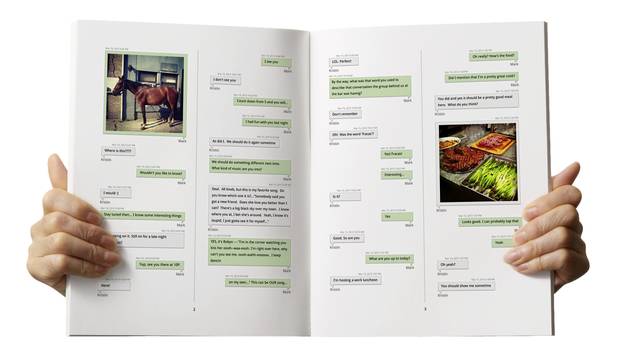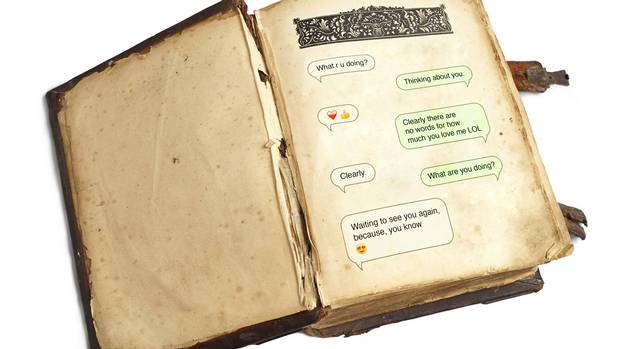When comedian Aziz Ansari began courting his girlfriend, he put his flirtatious text messaging game into overdrive. Nonchalantly, he invited the woman out for "din din," dropping references to his standup career and Hokey Pokey cookies, the ones she baked at Momofuku Milk Bar, where she worked as pastry chef.
Privately though, Ansari was freaking out: He had frantically vetted that cookie text with a friend, rewriting the message several times. And to avoid looking "over-eager," he waited until 10:13 the next morning to hit send.
Ansari landed the date, and a year later, his girlfriend resuscitated those first tentative notes, gifting Ansari a large book that compiled their entire text-message history up to the first anniversary. It was a voyeuristic peek into the early, heady days of their relationship. They were typed and time-stamped memories that people who dated in the era of landlines never had the privilege (or embarrassment) of revisiting this way.
"Digital technology gives all of us the chance to have this very unique record of our romantic relationships," Ansari observed in his recent book Modern Love, which traces the impact technology is having on our intimate lives. "Although these new tools may cause us all stress and angst," he continued, "the same technology has also given us all a new place to store, remember and share our love for each other."
Like Ansari and his girlfriend, a growing number of partners are taking stock of romantic relics buried in their technology. With modern courtship now spanning texts, e-mails, Facebook posts, WhatsApp messages, online dating site exchanges and Instagram photos, some couples don't want their experiences locked away behind illuminated screens. The more retrospective among us want to collect those archives in one place, print them and hold them closer.
A number of apps and services have started catering to people with that nostalgic urge, turning digital ephemera into more tangible artifacts – from encyclopedia-sized tomes of personal e-mails, to high-quality magazines featuring your most treasured Instagram snaps, to old-timey paper scrolls printed with special text-message exchanges.
For her 10th wedding anniversary, Montreal journalist Marion Kressmann received three such scrolls from her husband, Sylvain Lumbroso. With the help of a service called Tx.to, Lumbroso printed eight months' worth of long-distance courtship texts onto the tiny scrolls. In the last message, the two finally agreed to meet in person. "It was a good memory that we keep as a symbol of our marriage," said Kressmann, 39, who plans on leaving the scrolls to her two daughters as something of a legacy.

Txt-book lets people compile their texts in books and magazines.
Tx.to launched two years ago in France, after co-founder Martin Daniel decided to print out his text message history with a long-distance girlfriend as a gift. Since then, Tx.to has processed about 100 million texts. Most customers are partners printing off their giddy first exchanges, although some go further. One of Tx.to's largest shipments was 300 scrolls at once; the client was a husband who had recently lost his wife. "Those text messages tell the story you had with somebody from the beginning when you first met to the path you've had together," Daniel said.
Another service, txt-book, an app for Android and iPhone, lets people compile their texts in books and magazines in one of two formats: one looks like the text bubbles on your smartphone and the other is typeset like a romance novel.
"We call it the modern love letter, these text-message snippets that we send back and forth every day in relationships," said Scott Kochlefl, a 36-year-old who came up with the idea with his husband, George Tyler Barnet.
Barnet, 32, decided to compile a book of texts for their six-month anniversary. He had to manually transcribe all of the texts in Microsoft Word, a process that took three weeks. The two decided to make the process more seamless for other couples.
"We'll take out our books every six months and pick a random page," Kochlefl said of his own txt-book. "We're on the floor, dying and laughing. You change so much and you don't realize it until you can actually look at it all. It's like people wishing they had somebody take their picture on the day they met. Here, you can go back to a specific day or a random page and see what was on your mind that day, what was a big deal and what wasn't. Did you have a fight or did you not? It's a very interesting chronological diary of your relationship."
Kochlefl said the book form lets couples trace the arch of a relationship from coy banter to the steamy months, right through to the domesticity of a long-term union: "It's basically down to the grocery lists, but people like to save this stuff." Some partners even make books after a breakup: "Think of it as volumes on your bookshelf," Kochlefl said. "This was Jeff. This was Jim. This is Chris."
Indeed, the sheer volume of romantic correspondence today is staggering: most txt-books contain between 10,000 and 25,000 text messages, with many of the relationships just a year old. "We just created a txt-book that had 179,000 texts in it," said Kochlefl, who routinely compiles 500-page, dictionary-sized tomes that go back five years. "Can you imagine the First World War, trying to send a love letter? You'd get three of them," he said with a laugh.

Tx.to produces old-timey paper scrolls printed with special text-message exchanges.
Constant connection is a hallmark of our modern relationships, which makes archiving all the more complicated. We send roughly 224 million text messages a day in this country, this as phone calls decline. Dating in the era of snail mail and phone calls meant there were far fewer momentoes to catalogue, said Wendy Duff, interim dean of the faculty of information at the University of Toronto.
"So much of our conversation used to be face-to-face. Then, we have these beautiful letters from the 1800s. Then the phone comes in and replaces that letter writing. Now, lo and behold, we have texts, a medium of writing for which there is a record left," said Duff, who studies archives. "This need to hold onto something that we might not be able to revisit is a deep part of us."
Duff said that putting your most prized texts, e-mails and photographs on paper signals a distrust for the digital and an urge for preservation – for when your hard drive inexplicably crashes and corrupts all of your wedding photos. "Here we are taking a link to our most precious memories and we put it into what is really a black box. There is a very real fear – as a person who's constantly breaking my phone – that you will lose these items. They seem so much more ephemeral in the digital world."
George Sylvain, who co-founded Social Print Studio, which prints customers' photos onto pretty much any surface off-screen, echoes Duff, adding that some of his clients really don't trust the Internet with their stuff. "Baby photos especially can lead to this extra level of distrust: 'Who owns my baby photos?' Getting them printed is a nice way to declare your ownership over them."
Also leery of storing thousands of baby pictures on their phones, Scott Valins and his wife Elizabeth founded Recently, a monthly print magazine curated from your personal Instagram photos. Set to launch in Canada in February, the subscription service lets users pick their favourite most recent 100 Instagram pics, printing them on hard card stock for $8.99 (U.S.) an issue.
"We're of that generation that has one foot in the analog world and one in the digital, and we felt unfulfilled having all of this stuff behind a screen," said Valins, adding that aside from parents, expats and military families are sending loved ones these personal magazines to share what life is like where they are.
That's the heartwarming side of the trend. It isn't hard, however, to read some of its proponents' projects as an exercise in self-absorption. A magazine customized with your Instagram pics goes well beyond the family album, positioning its subject as a lifestyle brand.
"I'm sure there are some people out there who are going to make books of selfies," Valins acknowledged. But he added that it's human to look at photos: "It's something you're supposed to hold and think about."
As for archiving your honeymoon-phase texts in a hardcover book, Kochlefl said this also comes with hidden benefits. Such tangible evidence of courtship can serve as a reminder for long-term, committed couples to step it up.
"You really do forget how much you try in the beginning," Kochlefl said. "It's really nice to go back and remember that you actually tried to impress the other person. We really put a lot of time and energy into relationships and it's nice to remember that we still have to."
